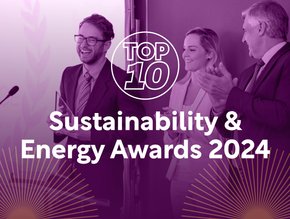10 Breakthrough Ideas in Energy For The Next 10 Years

The Global Energy Association presented its second annual report Ten breakthrough ideas in energy for the next 10 years at the Petersburg International Economic Forum, organised by the Roscongress Foundation. The report features technologies to be used to solve the most pressing problems of modern energy – lowering CO2 emissions, reducing the environmental footprint and finding less expensive ways to use innovations in energy. Here are the 10 breakthrough ideas highlighted in the report.
10: Power to E-Fuel
The electrification transition of societies requires large-scale electrical power conversion - and a simplified electrical powered energy system. Alongside renewable energy and storage, the report considers the role of offshore wind and 'Power to X'.
09: Ultra High Voltage Power Transmission Technology
UHV power transmission technology has the advantages of large transmission capacity, low line loss and saving land resources. Moreover it can improve the economics of the power grid and provide a way for new energy consumption to reduce pollution emissions.
08: Technologies for Managing Oil Field Wastes
The volume of waste generation increases annually, attributable to drilling, treatment, cleaning and spills. The application of a systematic approach in the field of oil waste recycling would be a "breakthrough direction," the report notes, providing an opportunity for uniform collection and processing.
07: High Temperature Heat Pumps
There are currently more than 30 million heat pumps in operation, from several KW to hundreds of MW. Pressures on electricity consumption are rising across the board - data centers alone account for 10% of total demand, and rising. The report considers vapour compression heat pumps and other new technologies. The share of residential heat supplied by heat pumps globally must triple by 2030, according to the IEA.
06: High-Quality Motor Fuels from Vegetative Raw Materials
The carbon in fossil-derived fuels contributes significantly to climate change, and the development of renewable biofuels and bioproducts is critical to energy, environmental and economic security. The report considers ethanol, butanol, fusel alcohols and polyketides - and acknowledges the challenges of scaling up biofuels for our myriad energy needs.
05: Catalytic Methods for Processing Carbon Dioxide from Coal-Fired Generation
The catalytic conversion of CO2 can take place in gas or liquid phase, or electrochemical cells. The report considers the processes in the gas phase with participation of catalysts: metal oxides, supported metals, carbides and carbon materials. Processes using heat and light as energy sources will undoubtedly be required to minimise energy consumption.
04: Blue Hydrogen
Hydrogen is set to play a major role in the energy transition. Blue Hydrogen (hydrogen produced from steam reforming of natural gas) applies CCS techniques and is already available. Today, hydrogen is used mostly in oil refining and for the production of fertilisers. For it to make a significant contribution to clean energy transitions, it also needs to be adopted in sectors where it is almost completely absent at the moment, such as transport, buildings and power generation.
03: Floating Solar Stations
With the global growth in population placing more pressure on resources and land use - coupled with rising demand for renewable energy - floating PV concepts are gaining favour, especially with water accounting for 71% of the world's surface. They can prevent water evaporation in dry regions but the downsides are challenges with maintenance and components, reduced oxygen concentration of water and dealing with birds.
02: Digital Twins
Energy is an industry where digital twins are in high demand across oil, gas and nuclear sectors. Digital Twins - an effective tool for visualisation - differ from traditional CAD systems, neither are they another sensor-enabled or IoT solution. It is assumed that in future, DT will become an integrating platform between operational technologies.
01: Industrial Carbon Capture and Storage Technologies
There is consensus among experts, engineers and geologists that it is safe to permanently inject and store carbon dioxide. Five more CCUS facilities are being constructed and another 20 are in the pipeline. However, industrial facilities are capturing less than 1% of the CO2 that is required to meet Paris Climate targets for 2040 - and industry accounts for one-quarter of CO2 emissions from energy and industrial processes and 40% of global energy demand.






